1st Lanarkshire Artillery Volunteers
The 1st Lanarkshire Artillery Volunteers were formed in 1859 as a response to a French invasion threat. Its units fought at Gallipoli and in Palestine during World War I, and in Normandy and North West Europe during World War II. It continued in the postwar Territorial Army until 1961.
| 1st Lanarkshire Artillery Volunteers 1st Lanarkshire RGA (V) 3rd Lowland Brigade, RFA 80th (Lowland – City of Glasgow) Field Regiment, RA 280th (City of Glasgow Artillery) Field Regiment, RA | |
|---|---|
| Active | 1859–1961 |
| Country | |
| Branch | |
| Type | Artillery |
| Role |
|
| Size | Up to 4 brigades/regiments |
| Part of | 52nd (Lowland) Division |
| Garrison/HQ | Glasgow |
| Engagements |
|
Artillery Volunteers 1859-1908
The enthusiasm for the Volunteer movement following an invasion scare in 1859 saw the creation of many Rifle, Artillery and Engineer Volunteer Corps composed of part-time soldiers eager to supplement the Regular British Army in time of need.[1][2] A number of Artillery Volunteer Corps (AVCs) were raised in Glasgow and its suburbs in Lanarkshire. The 1st Administrative Brigade Lanarkshire Artillery Volunteers was formed, with headquarters at Glasgow, on 6 March 1860, comprising the following AVCs of one battery each: [3][4][5][6]
- 1st Corps accepted for service on 30 December 1859
- 2nd Corps accepted for service on 30 December 1859
- 3rd Corps accepted for service on 30 December 1859
- 4th Corps (1st Northern) accepted for service on 6 December 1859
- 5th Corps (2nd Northern) accepted for service on 27 December 1859
- 6th Corps (3rd Northern) accepted for service on 27 December 1859
- 7th Corps (1st Eastern, Gallowgate) accepted for service on 10 January 1860
- 8th Corps (Ironmongers) accepted for service on 10 January 1860
- 9th Corps (2nd Eastern) accepted for service on 30 January 1860
- 10th Corps (Calton Artisans) accepted for service on 16 February 1860
- 11th Corps (Maryhill Artisans) accepted for service on 5 March 1860
- 12th Corps (Western) accepted for service on 12 May 1860
- 13th Corps (Hillhead and Dowanhill) accepted for service on 24 July 1860
- 14th Corps accepted for service on 26 July 1860
- 15th Corps (Partick), accepted for service on 2 November 1860
The 4th, 5th, 6th, 10th, and 11th were artisan corps, the men of which paid 2s. 6d. entry money, and 30s. for their uniforms, the remaining expenses being met by outside subscriptions, and the first four being assisted from the Glasgow Central Fund. The 1st Corps was formed, it is said, at the suggestion of Prince Albert, made at the opening of the Loch Katrine waterworks on 14 October 1859, that Glasgow should form some artillery. Mr John Wilkie, a leading lawyer of the city, took the matter in hand, and so many members joined the corps that from the outset three batteries could be formed, which were numbered the 1st, 2nd, and 3rd. These were entirely self-supporting, the honorary members paying £5 each, on enrolment, to the funds, and the effective members subscribing 10s. each annually and buying their own uniform and belts at a cost of £4 a-head. The remaining corps were raised on similar principles. In 1862, the brigade was consolidated as the 1st Lanarkshire Artillery Volunteers of fifteen batteries, which retained their former numbers.[4][5]
The 1st Lanarkshire had a number of different buildings in various Glasgow locations, including 260 St. Vincent Street in the 1870s, and 98 Sauchiehall Street in the 1890s.[6] By the early 20th Century the unit possessed an orderly-room, officers' and serjeants' club, and headquarters (HQ) at 8 Newton Terrace, Sauchiehall Street. The corps had five separate drill halls in different parts of the city, each with harness rooms, gun-sheds etc. for two batteries. The Maryhill drill hall accommodated all the ammunition waggons when not in use in the batteries.[7] For over 30 years, the corps carried out its annual practice at Irvine, from Bogside Camp, and as a rifle-range it used that at Darnley belonging to the 1st and 3rd Lanark Volunteer Rifle Corps.
Royal Garrison Artillery
In 1882 all the AVCs were affiliated to one of the territorial garrison divisions of the Royal Artillery (RA) and the 1st Lanarkshire AVC became part of the Scottish Division. In 1889 the structure was altered, and the corps joined the Southern Division. In 1899 the RA was divided into separate field and garrison branches, and the artillery volunteers were all assigned to the Royal Garrison Artillery (RGA). In 1902 their titles were changed, the unit becoming the 1st Lanarkshire Royal Garrison Artillery (Volunteers).[5][6]
In 1900, the whole corps volunteered its services for South Africa. This was not accepted, as Artillery units weren't required. However, 62 members of the corps, including Lieut. J. C. Clark, served in various capacities in South Africa during the war.[4]
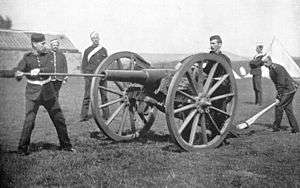
Position artillery
The AVCs were intended to serve as garrison artillery manning fixed defences, but a number of the early units manned semi-mobile 'position batteries' of smooth-bore field guns pulled by agricultural horses. Up to 1865, the only guns on which the Lanarkshire batteries were drilled were 32-pounder smoothbores, but on 13 December of that year, a sixteenth battery was raised and equipped as a field battery with four 6-pounder smoothbore field-guns. (The 17th Battery was formed as a garrison company in 1868.) At that time the position batteries were not officially supported by the War Office (WO).[4][5][8][9] In 1876, the 1st Corps won the Queen's Prize at the annual National Artillery Association competition held at Shoeburyness.[10]
The 'position artillery' concept was revived in 1888 when some Volunteer position batteries were reorganised to work alongside the Volunteer infantry brigades. The 1st Lanarkshire was nominated to operate two position batteries, each of four 16-Pounder Rifled Muzzle Loading guns and two wagons. The two batteries were manned by the personnel of four garrison batteries (including the former 16th). In 1900, the strength of the corps was increased to twenty batteries. As a result, eight more 16-pounder RML batteries were issued to it, and the whole corps was reorganised into ten position batteries, numbered 1st to 10th. These were divided into five brigades. As the corps was then entirely of position batteries, it was in 1901 styled a "position artillery corps", and in 1902 "heavy artillery". However, despite the new issue of equipment, harness was only provided for three batteries, making five in all. It wasn't until 1905 that harness for the remaining five was issued.[4][5][8]
In November 1905 the Army Council agreed an experiment to convert some RGA Volunteers to a field artillery role. The 1st Lanarkshire RGA (V) was one of the units chosen to be re-equipped with Ehrhardt quick-firing (QF) guns, but a change in government early the following year put a stop to the experiment. Instead, the new Secretary of State for War, Richard Haldane, embarked on a thorough-going reorganisation of all the Army's auxiliary forces.[11] In 1907-8, the 16-pounder guns were replaced by 15-pounder Breech Loading guns, which had been converted into quick-firers. The corps was the only one in Scotland composed entirely of heavy batteries.[4]
Territorial Force
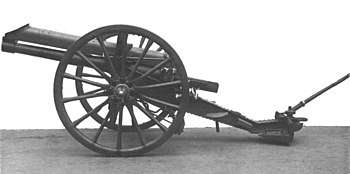
The Volunteers were subsumed into the new Territorial Force (TF) under the Haldane Reforms of 1908[12][13][14] and the personnel of the 1st Lanarkshire RGA were distributed to two new units of the Royal Field Artillery (RFA):[5][6][15][16]
III (or 3rd) Lowland Brigade'
- HQ at 8 Newton Terrace, Charing Cross, Glasgow
- 1st City of Glasgow Battery at Berkeley Street, Charing Cross, Glasgow[17]
- 2nd City of Glasgow Battery at Percy Street, Maryhill, Glasgow
- 3rd City of Glasgow Battery at Keppochhill, Springburn, Glasgow
- 3rd Lowland Ammunition Column at Percy Street, Maryhill, Glasgow
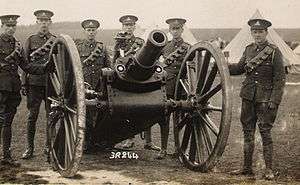
IV (or 4th) Lowland (Howitzer) Brigade
- HQ at 8 Newton Terrace, Charing Cross, Glasgow
- 4th City of Glasgow (Howitzer) Battery at Butterbiggins Road, Govanhill, Glasgow[17]
- 5th City of Glasgow Battery at Elder Street, Govan, Glasgow
- 4th Lowland (Howitzer) Ammunition Column at Butterbiggins Road, Govanhill, Glasgow
These units were part of the TF's Lowland Division. The field batteries were each issued with four 15-pounder guns and the howitzer batteries with four 5-inch howitzers.[6][16][18][19][20][21]
World War I
Mobilisation
The Lowland Division had been attending annual camp on the Ayrshire coast when the order to mobilise was received at 17.25 on Tuesday August 1914. Mobilisation began the following day at unit drill halls. On 12 August the division was ordered to concentrate at Bedford and entrainment began on 15 August. Concentration was completed by 17 August and the division formed part of First Army (Home Forces) in Central Force.[19][20][21]
On the outbreak of war, units of the Territorial Force were invited to volunteer for Overseas Service. On 15 August the WO issued instructions to separate those men who had signed up for Home Service only, and form these into reserve units. Then on 31 August the formation of a reserve or 2nd Line unit was authorised for each 1st Line unit where 60 per cent or more of the men had volunteered for Overseas Service. The titles of these 2nd Line units would be the same as the original, but distinguished by a '2/' prefix. In this way duplicate batteries, brigades and divisions were created, mirroring those TF formations being sent overseas.[19][20][22]
1/III Lowland Brigade
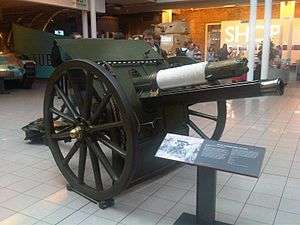
1/III Lowland Brigade was re-armed with 18-pounder guns and served with the Lowland Division (52nd (Lowland) Division from May 1915) in Egypt and Palestine. It was redesignated CCLXII (or 262) Brigade, RFA in 1916. It transferred to 7th (Meerut) Division when the 52nd left for the Western Front in March 1918 and served with this Indian Army formation in Palestine until the end of the war.[16][19][20]
2/III Lowland Brigade
2/III Lowland Brigade served with the 2nd Lowland Division (65th (2nd Lowland) Division from August 1915) in Scotland and England. It was redesignated CCCXXVII (or 327) Brigade, RFA, in May 1916 but does not appear to have been with the division after it went to Ireland in 1917 and was probably broken up.[16][23][24]
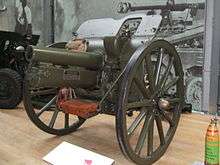
1/IV Lowland Brigade
1/IV Lowland Brigade served with 52nd (Lowland) Division at Gallipoli and in Egypt, where it was re-equipped with 4.5-inch howitzers. It was renumbered CCLXIII (or 263) (H) Brigade, RFA in September 1916 but broken up at the end of the year.[16][19][20]
Interwar years
In 1920 the 3rd and 4th Lowland brigades reformed as a single 3rd Lowland Brigade, which was redesignated as the 80th (Lowland) Brigade, RFA, the following year when the TF was reconstituted as the Territorial Army (TA). It became a 'Field Brigade, RA', when the RFA was subsumed into the Royal Artillery in 1924, and its subtitle was changed to 'Lowland – City of Glasgow' in 1937. It continued to be part of 52nd (Lowland) Division and had the following organisation:[6][16][25]
- HQ at 21 Taylor Street, Townhead, Glasgow
- 317 (1st City of Glasgow) Bty at Burkley Street, Glasgow
- 318 (2nd City of Glasgow) Bty at Percy Street, Maryhill, Glasgow
- 319 (3rd City of Glasgow) Bty at 21 Taylor Street, Townhead, Glasgow
- 320 (4th City of Glasgow) (Howitzer) Bty at Butterbiggins Road, Glasgow
Field Brigades were termed Field Regiments from 1938 onwards.[6][16]
World War II
Mobilisation
The TA was doubled in size following the Munich Crisis of 1938, with existing units splitting to form duplicates before the outbreak of World War II. 80th Field Regiment reorganised as follows:[16][26]
80th (Lowland – City of Glasgow) Field Regiment
- RHQ at Glasgow
- 317 (1st City of Glasgow) Field Bty at Glasgow
- 318 (2nd City of Glasgow) Field Bty at Maryhill
131st Field Regiment
- RHQ at Glasgow
- 319 (3rd City of Glasgow) Field Bty at Glasgow
- 320 (4th City of Glasgow) Field Bty at Townhead
The establishment of a field battery was increased to 12 guns organised into three Troops.[27]
80th (Lowland - City of Glasgow) Field Regiment
80th Field Regiment mobilised in 52nd (Lowland) Infantry Division.[26][28][29] Apart from a period in June 1940 when the rest of the division was briefly deployed to France, the regiment served with the 52nd (L) Division throughout the war, including the campaign in North West Europe from October 1944 to VE Day. It was placed in suspended animation in 1946[28]
131st (Lowland - City of Glasgow) Field Regiment
131st Field Regiment mobilised in 15th (Scottish) Infantry Division and served with it throughout the war, including the Normandy Campaign and North West Europe.[26][30][31] The regiment received its 'Lowland - City of Glasgow' subtitle in 1942. It was disbanded in 1947[16]
Postwar
When the TA was reconstituted in 1947, the regiment reformed as 280th (Lowland – City of Glasgow) Medium Rgt, reverting to being a field regiment in 1950. In 1955 the subtitle was changed to 'City of Glasgow Artillery'. The regiment formed part of 85 (Field) Army Group Royal Artillery, which was redesignated HQ RA 52nd (Lowland) Division in 1950. The regiment ha the following organisation:[16][32][33][34]
- RHQ at Glasgow
- P (1st City of Glasgow) Bty
- Q (2nd City of Glasgow) Bty
- R (3rd City of Glasgow) Bty
When the TA was reduced in 1961, most of the regiment amalgamated with 279th (Ayrshire) Fd Rgt to form 279th (City of Glasgow & Ayrshire) Fd Rgt:[16][34]
- RHQ at Troon
- P (1st City of Glasgow) Bty
- Q (Ayrshire) Bty
- R (3rd City of Glasgow) Bty
Surplus personnel of 280th Fd Rgt transferred to 445th (Lowland) Light Anti-Aircraft Rgt.[34]
Uniforms and insignia
The original uniform of all the Lanarkshire AVCs was similar to that of the Royal Artillery, with busbies and white waist-belts, but with scarlet cuffs and forage caps with scarlet bands.[5][4][35]
A brass shoulder title consisting of T over RFA over CITY OF GLASGOW was worn by all batteries of 3rd and 4th Lowland Brigades from 1908. In 1931, Lord Lyon King of Arms authorised a regimental crest for 80th Fd Bde consisting of a field gun surmounted by an oak tree bearing a robin and bell, taken from the Coat of arms of Glasgow. Above the tree was a King's crown and scroll inscribed with the RA motto 'UBIQUE' ('Everywhere'). Below the gun was a three-part scroll inscribed 'CITY OF GLASGOW ARTILLERY'. The crest was used on leatherheads, Christmas cards etc. However, from 1955 the design was used as a collar badge (gilt for officers, brass for other ranks) by 280th (City of Glasgow) Fd Rgt.[16]
Commanding officers
The commanding officers of the unit included:[4][6]
- Lt-Col Wm. S. S. Crawford, 7 February 1861
- Lt-Col Jas. Keid Stewart, 12 May 1862
- Lt-Col John Kidston (hon. col.), 10 March 1875
- Lt-Col Robt. J. Bennett, VD, (hon. col.), 27 September 1890
- Lt-Col Alexr. B. Grant, MVO, VD, (hon. col.) 2 January 1895
- Lt-Col Archibald Mclnnes Shaw, VD (hon. col.), 16 November 1907
Honorary Colonels
The following served as Honorary Colonel of the unit:[4][6]
- William S.S. Crawford (former CO), appointed 8 January 1870
- William Cavendish-Bentinck, 6th Duke of Portland, appointed 8 March 1884
- Sir Charles Cayzer, 1st Baronet, appointed 23 March 1898, continued with 3rd Lowland Brigade
- Alexander B. Grant, MVO, VD, (former CO) appointed to 4th Lowland Brigade 23 November 1912
- Sir Archibald McInnes Shaw, CB, VD, (former CO) appointed to 80th Lowland Brigade 21 December 1921
Prominent members
Dr George Beatson, the cancer specialist, joined the 1st Lanarkshire AV when he moved to Glasgow in 1878 (promoted to lieutenant 26 June 1880 and captain 22 July 1885). In 1890 he left to become commanding officer of the Glasgow companies of the Volunteer Medical Corps, and was later Principal Medical Officer of the Lowland Division.[6][36]
Notes
- Beckett.
- Spiers, pp. 163–8.
- Becket, Appendix VIII.
- Grierson, pp. 143–5.
- Litchfield & Westlake, p. 105.
- Army List, various dates.
- Osborne, pp. 278-9.
- Beckett, pp. 178–9.
- Litchfield and Westlake, pp. 3–6.
- Litchfield & Westlake, p. 189.
- Beckett, p. 246.
- Beckett, pp. 247–53.
- Dunlop, Chapter 14.
- Spiers, Chapter 10.
- London Gazette 20 March 1908.
- Litchfield, pp. 287–9.
- Lanarkshire at Great War Centenary Drill Halls.
- "Conrad, British Army, 1914". Archived from the original on 2006-02-19. Retrieved 2006-02-19.
- Becke, Pt 2a, pp. 109–15.
- 52 (L) Division at Long, Long Trail.
- 52 (L) Division at Regimental Warpath.
- Becke, Pt 2b, p. 6.
- Becke, Pt 2b, pp. 61–5.
- 65 (2nd L) Division at Long, Long Trail.
- Titles and Designations, 1927.
- Scottish Command 3 September 1939 at Patriot Files.
- Ellis France and Flanders, Appendix I.
- Joslen, pp. 85–6.
- 80 Fd Rgt at RA 1939–45.
- Joslen, pp. 58–9.
- 131 Fd Rgt at RA 1939–45.
- Litchfield, Appendix 5.
- Watson, TA 1947.
- 266–288 Rgts RA at Britiah Army 1945 onwards.
- Grierson, Plate V.
- 'New Beatson' at NHS Greater Glasgow and Clyde.
References
- Maj A.F. Becke,History of the Great War: Order of Battle of Divisions, Part 2a: The Territorial Force Mounted Divisions and the 1st-Line Territorial Force Divisions (42–56), London: HM Stationery Office, 1935/Uckfield: Naval & Military Press, 2007, ISBN 1-847347-39-8.
- Maj A.F. Becke,History of the Great War: Order of Battle of Divisions, Part 2b: The 2nd-Line Territorial Force Divisions (57th–69th), with the Home-Service Divisions (71st–73rd) and 74th and 75th Divisions, London: HM Stationery Office, 1937/Uckfield: Naval & Military Press, 2007, ISBN 1-847347-39-8.
- Ian F.W. Beckett, Riflemen Form: A Study of the Rifle Volunteer Movement 1859–1908, Aldershot, The Ogilby Trusts, 1982, ISBN 0-85936-271-X.
- Col John K. Dunlop, The Development of the British Army 1899–1914, London: Methuen, 1938.
- Major L.F. Ellis, History of the Second World War, United Kingdom Military Series: The War in France and Flanders 1939–1940, London: HM Stationery Office, 1954/Uckfield, Naval & Military Press, 2004.
- Maj-Gen James Grierson, Records of the Scottish Volunteer Force 1859–1908, Edinburgh: Blackwood, 1909.
- Lt-Col H.F. Joslen, Orders of Battle, United Kingdom and Colonial Formations and Units in the Second World War, 1939–1945, London: HM Stationery Office, 1960/Uckfield: Naval & Military, 2003, ISBN 1-84342-474-6.
- Litchfield, Norman E H, and Westlake, R, 1982. The Volunteer Artillery 1859-1908, The Sherwood Press, Nottingham. ISBN 0-9508205-0-4
- Litchfield, Norman E H, 1992. The Territorial Artillery 1908-1988, The Sherwood Press, Nottingham. ISBN 0-9508205-2-0
- Osborne, Mike, 2006. Always Ready: The Drill Halls of Britain's Volunteer Forces, Partizan Press, Essex. ISBN 1-85818-509-2
- Edward M. Spiers, The Army and Society 1815–1914, London: Longmans, 1980, ISBN 0-582-48565-7.
- War Office, Titles and Designations of Formations and Units of the Territorial Army, London: War Office, 7 November 1927 (RA sections also summarised in Litchfield, Appendix IV).
External sources
- Mark Conrad, The British Army, 1914 (archive site)
- British Army units from 1945 on
- Great War Centenary Drill Halls.
- The Long, Long Trail
- The Regimental Warpath 1914–1918
- Orders of Battle at Patriot Files
- The Regimental Warpath 1914–1918 (archive site)
- Royal Artillery 1939–1945 (archive site)
- Graham Watson, The Territorial Army 1947